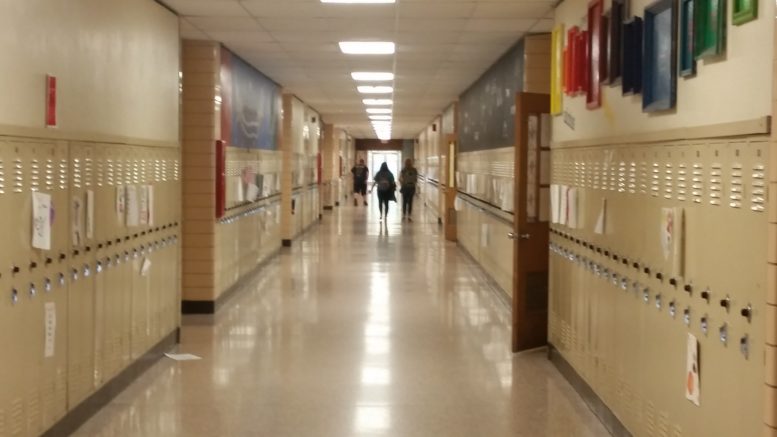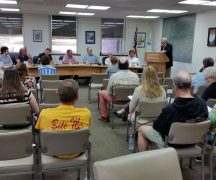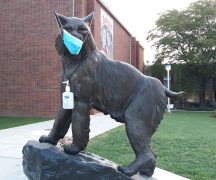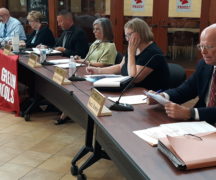By JAN LARSON McLAUGHLIN
BG Independent News
Bowling Green Board of Education crammed in a study session Tuesday evening before making its big decision on Thursday night about the district going to hybrid classes or remaining remote.
The decision rests on how the district can keep students and staff safe – while making sure students don’t fall behind – scholastically or socially.
Thursday’s meeting will be at 5:30 p.m., and can be viewed via YouTube at https://www.youtube.com/channel/UC02oJh_17esNcwnoFYejHtg
Emails from parents, staff and students have been coming in furiously, asking that the board stick with remote classes, switch to a hybrid system, or return to school full-time.
“This board has a big decision to make on Thursday,” Superintendent Francis Scruci said. “The board is going to make half the people happy and half the people upset.”
The board again got an update Tuesday from Wood County Health Commissioner Ben Robison, who presented a good news – bad news report.
The good news is that schools have not been the source of major COVID spreads.
“Generally speaking, cases identified in schools are not leading to more cases in the educational community,” unless districts fail to follow health guidelines, Robison said.
The bad news is that the case numbers continue to climb in the Bowling Green area, which is seeing more than 800 cases per 100,000 people. Of those, about 600 are from BGSU, and about 215 from the Bowling Green community, Robison said.
Board member Tracy Hovest asked how BGSU can still hold some in-person classes with the high COVID numbers generated by students.
“BGSU has a pretty good plan in place to prevent the spread of cases,” Robison said, pointing out that the virus is not spreading in classrooms.
The most important steps a school district can take to minimize the spread of COVID is to keep people 6 feet apart, require masks, promote handwashing, and keep kids home if they are sick, Robison said.
“Certainly those numbers Ben shared are a concern to me,” Scruci said.
The option of going back four or five days a week never made it on the table since the district would not be able to maintain social distancing in the classrooms or on buses if all the students were at school every day. Doing that would be a “roll of the dice” with COVID, Scruci said.
“Even if we cleaned out every classroom” and removed bookcases and other furniture, it would be impossible to have up to 25 students 6 feet apart from each other, Scruci said.
The other option that would get students back in the schools at least part time is the hybrid model. That model would require students to be divided into groups A and B. Group A would attend school on Tuesdays and Wednesdays, while Group B would attend on Thursdays and Fridays. The groups would follow regular school day schedules.
“So we can keep the class sizes as small as possible,” explained Angie Schaal, executive director of teaching and learning for the district. Transportation Director Toby Snow said students would have to ride one per seat to meet the standards.
Board President Ginny Stewart noted that the district will make sure that children from the same families will be put on the same schedule.
But Bowling Green does not have enough staff to conduct in-person classes and remote classes at the same time.
On the days the students aren’t in school, they would be asked to work on assignments independently. The district wanted to provide live online instruction – but teachers cannot be asked to teach in the classroom during the day, then teach again online after school, Schaal said.
Monday would be a deep cleaning day in the school buildings. That day was selected for cleaning since it matches with Penta Career Center, the transportation schedules for other schools using BG buses, and since most days off for holidays are on Mondays.
Board member Norm Geer voiced concern about there being no teacher supervision on the days students are not in school. They will have workbooks and assignments – but no teachers to instruct them.
Geer said he came into Tuesday’s meeting thinking that the hybrid plan would be better for students. But after hearing that their time with teacher instruction would actually be less, he said he changed his mind.
Currently, the students have four days of learning with their teachers in front of them on their screens – but no face-to-face interaction.
That remote learning has its limitations – both scholastically and socially.
At the high school, the staff is seeing some students slipping.
“The teachers are working extra hard to make lessons interactive,” Assistant Principal Dan Black said. But absenteeism and failure rates are up.
“Our at-risk students – that population is growing,” Black said. “It certainly is a concern.”
Stewart voiced concerns for the social-emotional wellbeing of students. Black agreed it’s a serious issue.
“We’re going to have to figure out what we can do for these at-risk kids,” he said. “We’re trying to be creative. We have to address this.”
Kenwood Principal Kathleen Daney said the elementary student attendance has been really good. “The majority of our students are performing really well.”
But Daney said she is concerned about neglected and abused children, who currently have no in-person interaction with their teachers.
Teachers were praised for doing their best with a difficult situation.
“Our teachers have really been committed and dedicated to doing the best they can,” Scruci said.
The district surveyed teachers, and found a variety of responses – with some saying online teaching is going better than they expected, and some struggling but understanding the need for safety measures.
“Every teacher I’ve talked to wants the kids in the building,” Daney said. But they don’t want to flip back and forth from remote to hybrid, she said.
Last week when internet and phone lines were down at some of the school buildings, teachers were temporarily cut off from their students. The teachers recovered and taught from their homes.
“Technology is a great thing when it works,” Scruci said.
“I think our teachers have really taken on the challenge” of bettering their use of technology, Schaal said.
She also praised the principals for stepping up to do home visits to check on children, and talking with parents.
Melanie Garbig, executive director of pupil services, also applauded district teachers.
“I commend the teachers, they are doing a fabulous job,” she said.
But Garbig voiced concerns about children losing the socialization skills which they learn at school.
“Nothing is going to replace a kid walking into a building,” she said. “Everybody can get used to doing it this way. But we’re missing that human element. I’m worried about their social-emotional development.”
Hovest pointed out that even some high achieving students are struggling.
“I just want to make sure kids aren’t falling through the cracks,” Stewart said.
Scruci prepared the board for Thursday’s meeting.
“This is not an easy decision,” Scruci said. “No matter what we do we’ll get criticized.”
“There have been a lot of sleepless nights,” Scruci said. “The last thing we want to do is put anybody at risk. And the last thing we want to do is let our kids fall behind.”
If the district goes to hybrid learning, teachers can opt out of in-person classes for medical reasons only. Scruci said he has heard of a couple staff members considering retirement or turning in resignations if the district goes back into the school buildings.
Stewart suggested if the board decides to switch to the hybrid method, that two board members meet with district administrators to try to determine the threshold of COVID cases it would take for the district to revert back to remote classes.
Hovest suggested that a threshold also be identified that would allow the district to go back to school full time.
Scruci reminded the board that no matter how careful the district is, there will be COVID cases.
“We’re going to go the best that we can,” he said. “We’re following all the guidelines.”
If students return to school buildings, there will be a nurse in each school, stepped up cleaning, plenty of hand-sanitizing stations, and water bottle fillers in place of water fountains. Parents will be asked to check their children’s temperature before sending them to school.
Schaal pointed out that the state has not given school districts grace on the mandatory third grade reading tests. They must be taken in person sometime between Oct. 19 to 30. So third graders will be required to be in school sometime during that period.





